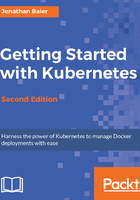
The architecture
Although, Docker brings a helpful layer of abstraction and tooling around container management, Kubernetes brings similar assistance to orchestrating containers at scale and managing full application stacks.
K8s moves up the stack giving us constructs to deal with management at the application or service level. This gives us automation and tooling to ensure high availability, application stack, and service-wide portability. K8s also allows finer control of resource usage, such as CPU, memory, and disk space across our infrastructure.
Kubernetes provides this higher level of orchestration management by giving us key constructs to combine multiple containers, endpoints, and data into full application stacks and services. K8s also provides the tooling to manage the when, where, and how many of the stack and its components:

In the preceding figure, we see the core architecture of Kubernetes. Most administrative interactions are done via the kubectl script and/or RESTful service calls to the API.
Note the ideas of the desired state and actual state carefully. This is the key to how Kubernetes manages the cluster and its workloads. All the pieces of K8s are constantly working to monitor the current actual state and synchronize it with the desired state defined by the administrators via the API server or kubectl script. There will be times when these states do not match up, but the system is always working to reconcile the two.